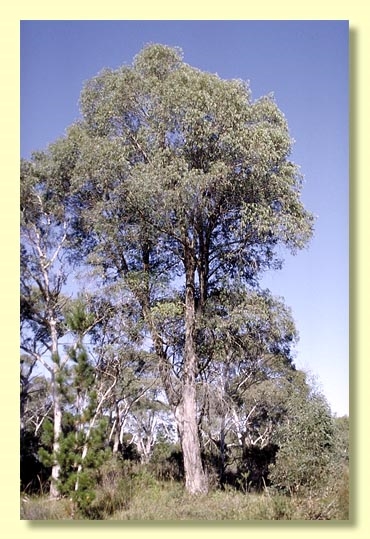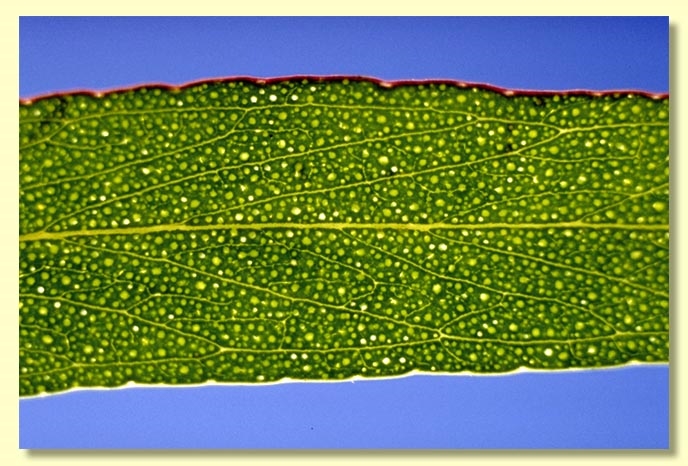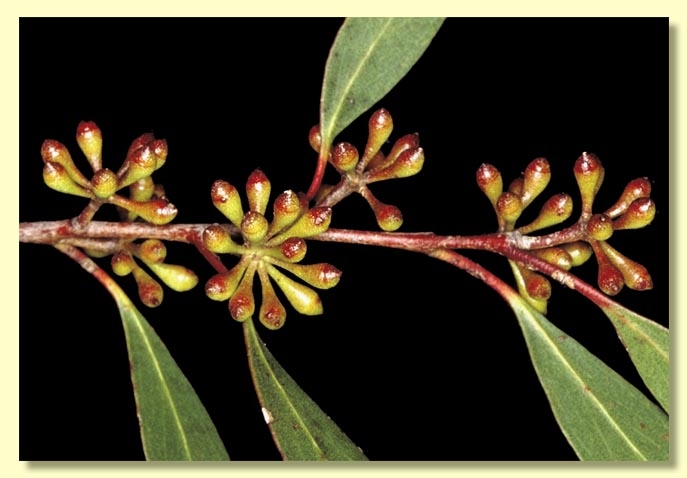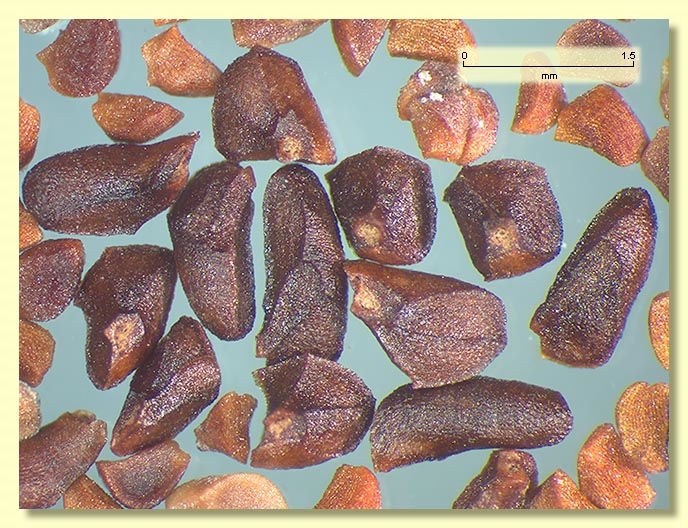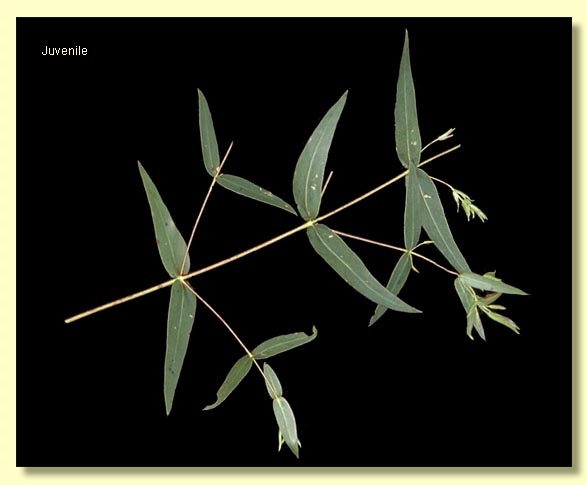Euclid - Online edition
Eucalyptus radiata subsp. radiata
Eucalyptus | Eucalyptus | Aromatica | Radiatae
Eucalyptus radiata Sieber ex DC., Prodr. 3: 218 (1828) subsp. radiata
Eucalyptus amygdalina var. radiata (DC.) Benth., Flora Australiensis 3: 203 (1867); E. amygdalina var. numerosa Maiden [nom. illeg.], Proc. Linn. Soc. New South Wales 2: 29 (4) 752 (1905). T: New South Wales, 1823, F.W.Sieber 475 [cited in error as Sieber 425]; holo: G; iso: F, G, K, L, MEL, W.
Eucalyptus australiana R.T.Baker & H.G.Smith, J. Roy. Soc. New South Wales 49: 514 (1916); E. radiata var. australiana (R.T.Baker & H.G.Smith) Blakely, Key Eucalypts 211 (1934). T: ?Nerrigundah, NSW, 1913, W.F.Farrell s.n., herbarium of cited specimen not known to us.
Eucalyptus phellandra R.T.Baker & H.G.Sm., Res. Eucalyptus 2nd edn, 280 (1920). T: Moss Vale, NSW, 22 Nov. 1917, C.J.Clulee s.n.; syn: NSW; Monga, NSW, July 1898, W.Bäuerlen s.n.; syn: NSW.
Eucalyptus radiata var. subexserta Blakely, Key Eucalypts 211 (1934). T: Jenolan Caves, NSW, 18 July 1899, W.F.Blakely s.n.; syn: NSW; Jenolan Caves, NSW, Nov. 1928, J.C.Wiburd s.n.; syn: NSW.
Tree to 40 m tall. Forming a lignotuber.
Bark rough to small branches or the branches < 8 cm diameter smooth, finely fibrous, peppermint-type, dark grey, or grey-brown, smooth bark grey.
Juvenile growth (coppice or field seedlings to 50 cm): stem rounded in cross-section, often warty; juvenile leaves opposite and sessile for many pairs, narrowly lanceolate to linear, thin, 3.3–10 cm long, 0.5–2 cm wide, bases lobed and stem-clasping or rounded, discolorous, green.
Adult leaves alternate, petiole 0.5–1.6 cm long; blade lanceolate to falcate or almost linear, 5.5–12 cm long, 0.6–1.5 cm wide, base tapering to petiole, concolorous, glossy or dull, green to blue-green or blue-grey, side-veins acute or parallel, sparsely to moderately reticulate, intramarginal vein parallel to and well removed from margin, oil glands island.
Inflorescence axillary unbranched, peduncles 0.2–1.2 cm long, buds 11 to 20 or more per umbel, pedicels 0.2–0.4 cm long. Mature buds clavate, 0.3–0.5 cm long, 0.2–0.3 cm wide, green to yellow, scar absent, operculum rounded or sometimes broadly conical, apiculate or not so, stamens inflexed or irregularly flexed, anthers reniform to cordate, versatile, dorsifixed, dehiscing by confluent slits, style short or long, stigma blunt or tapered, locules 3 or 4, the placentae each with 2 vertical ovule rows. Flowers white.
Fruit rarely sessile, usually on pedicels to 0.4 cm long, cup-shaped, hemispherical or truncate-globose, 0.3–0.6 cm long, 0.4–0.7 cm wide, disc slightly raised, level or slightly descending, valves 3 or 4, usually near rim level or enclosed.
Seeds black, brown or reddish brown, 1–2.5 mm long, pyramidal or obliquely pyramidal, dorsal surface smooth, hilum terminal.
Cultivated seedlings (measured at ca node 10): cotyledons reniform; stems rounded in cross-section, warty, non-glaucous; leaves sessile, opposite for many nodes, lanceolate, 3.5–10 cm long, 1–2.8 cm wide, amplexicaul or base rounded, margin entire, apex pointed, dull, grey-green to green.
Flowering has been recorded in January, October, November and December.
E. radiata has three subspecies between which morphological boundaries are not always distinct:
E. radiata subsp. radiata
It has a dense crown of narrow, usually glossy green leaves and green juvenile leaves that can be particularly narrow. The operculum is frequently rounded but conical opercula do occur on some plants; the operculum may be conspicuously apiculate also. It occurs from the Blue Mountains through the Southern Tablelands and Monaro Region of New South Wales to the highlands and foothills of north-eastern and central Victoria and the Otway Range. In Tasmania it is restricted to the upper valleys of the Wilmot, Mersey and Forth Rivers (see Williams & Potts (1996)).
E. radiata subsp. robertsonii
Subsp. robertsonii has a dull, grey-green to blue-green crown, leaves broader at all stages than those of subsp. radiata and buds that may be quite glaucous. The operculum is usually conical and often longer relative to total bud length than in subsp. radiata. It occurs at higher elevations near Canberra and along the western side of the Southern Tablelands of New South Wales often on granite soils. Its occurrence in Victoria has been debated with opinions of different botanists divided. The most recent study, Rankin (1998), concluded that it does occur in Victoria but is confined to mountain country in the north-east of the state. Rankin used a combination of data from morphology, and essential oil and flavenoid chemistry, to arrive at his conclusion. Rankin also concluded that the taxon is distinct from E. radiata at species level, not subspecies level, i.e. Eucalyptus robertsonii. In EUCLID we are, for the present, retaining this taxon at subspecies level as the morphological differences are slight. See below for comment on E. robertsonii subsp. hemisphaerica.
E. radiata subsp. sejuncta
It has broadly lanceolate to narrowly ovate, green juvenile leaves and glossy green leaves in the mature crown. The operculum is conical. Subsp. sejuncta is restricted to the eastern part of the Northern Tablelands of New South Wales and the Paling Yard Creek – South Bald Rock area of Girraween National Park on the Queensland – New South Wales border.
Specimens of Eucalyptus radiata will not always be easy to assign to a particular subspecies as the operculum character is a somewhat variable, and the development of glaucescence is highly variable.
Eucalyptus radiata belongs to Eucalyptus subgenus Eucalyptus section Aromatica (the peppermints) because the buds have a single operculum, anthers are reniform, ovules are in two rows, seeds are more or less pyramidal, adult leaf venation is acute to sub-parallel (rarely parallel) and juvenile leaves are sessile and opposite for many pairs. Within this section five closely related species form series Radiatae, viz. E. elata, E. radiata (with three subspecies), E. croajingolensis, E. willisii (with two subspecies), and E. dives. They differ from each other in bark and leaf characteristics, and, as a group, series Radiatae differs from the endemic Tasmanian peppermints, series Insulanae, by having numerous oil glands in the juvenile leaves whereas species in series Insulanae have few oil glands in the juvenile leaves (series Insulanae includes E. puilchella, E. amygdalina, E. tenuis, E. tenuiramis, E. risdonii, E. nitida and E. coccifera).
Eucalyptus robertsonii subsp. hemisphaerica was described from plants in the Mullion Creek area north of Orange, New South Wales, and several other scattered localities in the area south of Mudgee to south-west of Oberon (Johnson & Hill, 1990). Rankin (1998, p. ix) concluded from his detailed studies that "The type specimens of E. robertsonii subsp. hemisphaerica appear to be hybrids between E. robertsonii and E. dives and hence this name is also not valid", though his meaning is unclear — the name was validly published, and it applies to certain trees which, in his opinion, are hybrids..
Eucalyptus robertsonii subsp. hemisphaerica is listed as "Vulnerable" under the Australian Government Environment Protection and Biodiversity Conservation Act 1999 (EPBC Act). Further information may be found at this web address:
http://www.environment.gov.au/cgi-bin/sprat/public/sprat.pl

